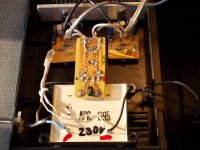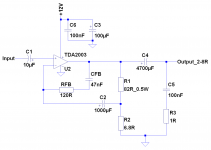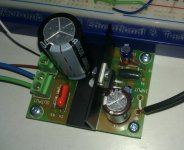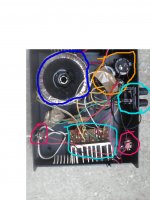how loud was the transformer buzzing then ....?? if it just a faint buzzing close enough to the transformer to hear it then it is normal
About as loud as a gas powered chainsaw,but now i fixed it.its now as loud as a computer fan.
It seems to have reduced hum under load,in short circuit or during the charging period of the caps.
It is very variable in loudness,and teperature is about 60c-80c,is it ok?.noise is reduced when i press on the metal casing.I will start winding toroidals,since they seem easier but i need the calculations for them!
Hey guys i replaced the original 0.1 uf ceramicaps with 0.47 uf flm caps and 1000uf,crapxons with 3300 nichicons and i love it,the dude at the shop had computer grade HE caps which are low esr,wich i used for output,
The bas is tighter and stonger,no longer needing bass boost,and the vocals are les muddy,less distorsion, overrall better sound,
This isnt its even final form,i will be soon upgrading the feedback caps in a couple of days.
and then supplementing it with an lm1875t amp,as i aleardy bought the chips,just need solder.
The bas is tighter and stonger,no longer needing bass boost,and the vocals are les muddy,less distorsion, overrall better sound,
This isnt its even final form,i will be soon upgrading the feedback caps in a couple of days.
and then supplementing it with an lm1875t amp,as i aleardy bought the chips,just need solder.
In 1994 the year I graduated I made my 1st amplifier made by TDA2006 and upc324 from the magazine 1984 for that time it's advanced. And when new century comes, TDA2030(A) became popular everywhere.
Now it's time for LM3886 no matter it's been used at least 10 years ago.
In my opinion, 2000 series' power consumption is less than current products and static noise is much larger even with accurate design and selection of Electronic Components. It's behind the times and we should purchase a newer and better life and forgive those old days.
Now it's time for LM3886 no matter it's been used at least 10 years ago.
In my opinion, 2000 series' power consumption is less than current products and static noise is much larger even with accurate design and selection of Electronic Components. It's behind the times and we should purchase a newer and better life and forgive those old days.
Class D... the future amps.
Ive had many 2000 series amplifiers I didnt like any of them, sometimes they sound boomy or have poor lows/low mids... :/
But one of my true, the most hated TDA1519CTH only 12V range stereo amp i had back then (SMD heatsink above), i designed perfect pcb and added PCM2704 as DAC, the whole thing was fully shielded with 0,5MM stainless steel.
The pcb was the size of a sound card.
It was used for many years by... home mom/dad, I HATED IT! Even, the shielding that was extreme, design, lowest noise single chip DAC i was able to find, superb cooling, best cables, monster filters, inductor before caps to get rid of dat SMPS/FAN noise.... Looks like one of those turbine cooled video cards
All that work, it failed permantently, still had hearable static noise and i never got rid of it.
I should take few pics of this thing, its truly my masterpiece, but next time Ill fully read the Datasheet or use TI/BB semiconductors only.
But Ive also buil my "High-End" version with TDA2030 😀
Its way better sounding than most of the 2000 series amps, i think its like 2050 with limiting...
Ive had many 2000 series amplifiers I didnt like any of them, sometimes they sound boomy or have poor lows/low mids... :/
But one of my true, the most hated TDA1519CTH only 12V range stereo amp i had back then (SMD heatsink above), i designed perfect pcb and added PCM2704 as DAC, the whole thing was fully shielded with 0,5MM stainless steel.
The pcb was the size of a sound card.
It was used for many years by... home mom/dad, I HATED IT! Even, the shielding that was extreme, design, lowest noise single chip DAC i was able to find, superb cooling, best cables, monster filters, inductor before caps to get rid of dat SMPS/FAN noise.... Looks like one of those turbine cooled video cards
All that work, it failed permantently, still had hearable static noise and i never got rid of it.
I should take few pics of this thing, its truly my masterpiece, but next time Ill fully read the Datasheet or use TI/BB semiconductors only.
But Ive also buil my "High-End" version with TDA2030 😀
Its way better sounding than most of the 2000 series amps, i think its like 2050 with limiting...
Nice stories.my tda2003 is dead silent even when a phone gets a call near it.i have 15000uf filtering but i should upgrade it
Thanks guys,my lm1875t was my first amp and it sounded like **** because i messed up the grounding,and no one wanted to help me,so i got angry and threw them out,but now,im broke and i cant afford them,sholuld have kept them,also the same for tda2050,the worked 10 secs,an power surge came in and blew the up,since i have 25v transformer and they have a maximum of 25v supply
If that was a 25V AC transformer output then your rectified and smoothed voltage would be around 35V DC (25*sqrt2), somewhat over the absolute maximum specification.
I used the TDA2003 years ago on a pre-assembled kit. At the time it was mostly so I could use a single supply and I never got to test it with any very high quality speakers, perhaps I should.
I've found the sound of the LM1875 very impressive in the projects I've used it but this has usually been with small 8 Ohm speakers. Perhaps the TDA2003 has improved relative performance into 4 Ohms, it being a design rooted in car audio.
I noticed many of you guys are confused,tda2003 gives 10w in an 1.6 ohms load not in 4 ohms.
about 5w in 4 ohms but realisticaly i dont get more than 2w in 2 ohms at 12v
about 5w in 4 ohms but realisticaly i dont get more than 2w in 2 ohms at 12v
I dug out my TDA board, it's actually TDA2002 but same circuit topology:
Cebek kits (E-2 module)
It's built to the datasheet application design and the first thing I noticed was far too much gain. This amplifier produces 2 Watts into 8 Ohms, so the voltage output is about 4V RMS. The voltage gain in the reference is set to 100x (40dB), so we could push it to clipping with just 40mV RMS input! I don't know any sources with such limited voltage drive, most can produce more like 500mV RMS.
R1 and R2 ratio can be altered to reduce gain, I'm not sure if there's a minimum but I'll present a design with 12x (21.6dB) gain, which I'm confident would be stable. On the kit I experimentally I added resistance in parallel with the 220R to lower its value and noted a substantial decrease in output noise, it actually became impressively quiet. In the schematic, R2 is also increased to lower gain further while keeping quiescent current reasonable. As a consequence, C2 is increased to keep PSRR high.
The high frequency feedback network is omitted on my kit but probably should be in place. The values I've shown should keep bandwidth to 40kHz or so, the 15kHz of the datasheet is somewhat restrictive.
The output coupling capacitor should be larger, not really to extend low end roll-off, but to minimise the voltage accross that capacitor and hence keep distortion low. This is optional and the device doesn't exhibit stellar distortion performance in the first place, the effect on turn on/off thump remains to be heard.
I'll give these changes a go on the little kit, shame it isn't the improved TDA2003 chip though.
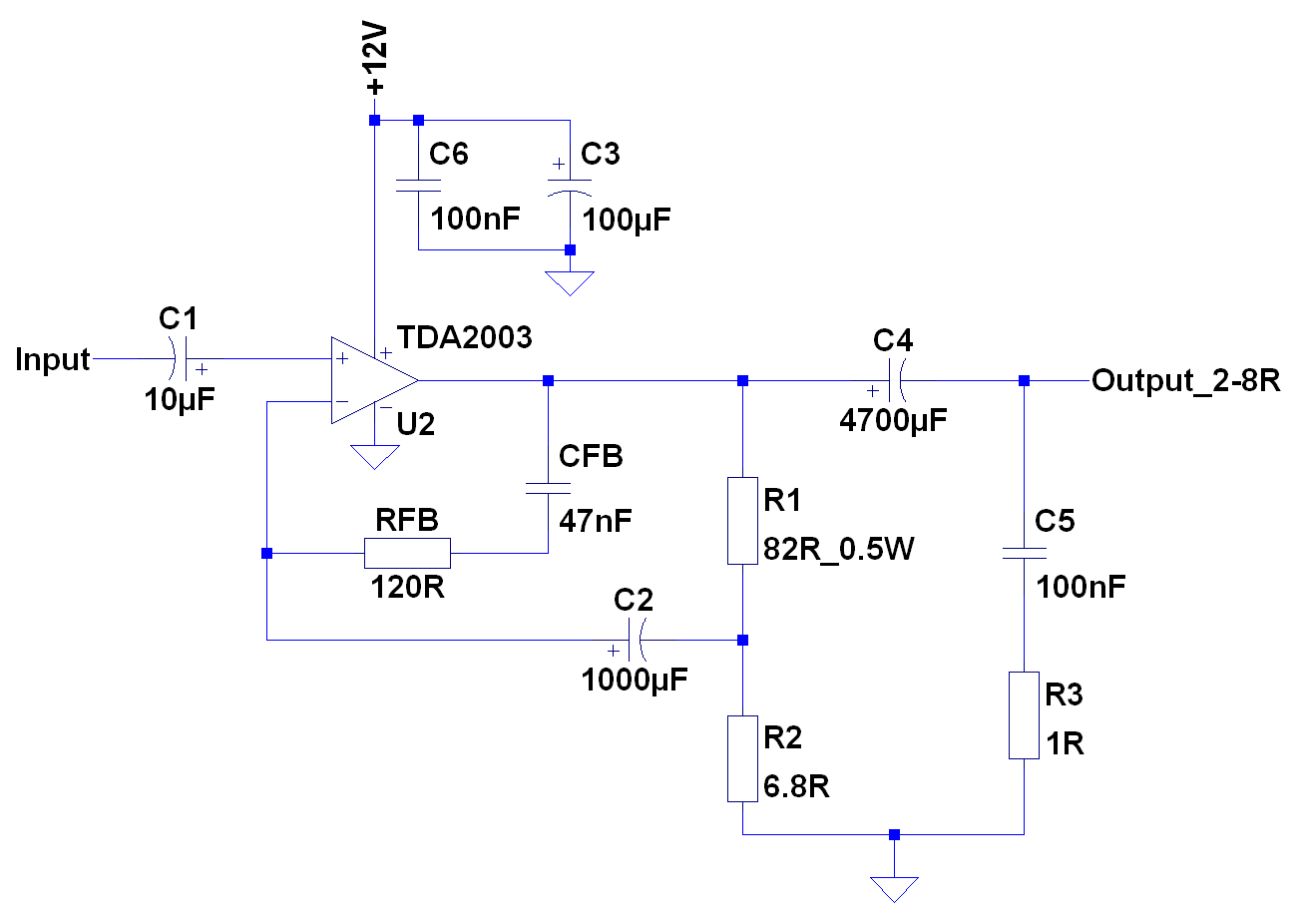
Cebek kits (E-2 module)
It's built to the datasheet application design and the first thing I noticed was far too much gain. This amplifier produces 2 Watts into 8 Ohms, so the voltage output is about 4V RMS. The voltage gain in the reference is set to 100x (40dB), so we could push it to clipping with just 40mV RMS input! I don't know any sources with such limited voltage drive, most can produce more like 500mV RMS.
R1 and R2 ratio can be altered to reduce gain, I'm not sure if there's a minimum but I'll present a design with 12x (21.6dB) gain, which I'm confident would be stable. On the kit I experimentally I added resistance in parallel with the 220R to lower its value and noted a substantial decrease in output noise, it actually became impressively quiet. In the schematic, R2 is also increased to lower gain further while keeping quiescent current reasonable. As a consequence, C2 is increased to keep PSRR high.
The high frequency feedback network is omitted on my kit but probably should be in place. The values I've shown should keep bandwidth to 40kHz or so, the 15kHz of the datasheet is somewhat restrictive.
The output coupling capacitor should be larger, not really to extend low end roll-off, but to minimise the voltage accross that capacitor and hence keep distortion low. This is optional and the device doesn't exhibit stellar distortion performance in the first place, the effect on turn on/off thump remains to be heard.
I'll give these changes a go on the little kit, shame it isn't the improved TDA2003 chip though.
Attachments
Nice info,thanks
mine is dead quiet,i cant even hear hum or hiss if i keep my ear close to the speaker,distorsion is very low and gain is 30x, gain resisitors are 10k and 330r i think
mine is dead quiet,i cant even hear hum or hiss if i keep my ear close to the speaker,distorsion is very low and gain is 30x, gain resisitors are 10k and 330r i think
I made the changes to my board, or as close as I could do with available parts. Huge improvement in idle noise, it's actually very low now, I measured it as best I could on my scope and it was just 200uV RMS, or -74dBV or so, hard to tell though since 5mV is the lowest scope setting and the trace just gets a little thicker when I connect the output compared to if the BNC is pulled out. This is with the input shorted and 10 Ohm resistive output load.
Output power before clipping was 1.6W RMS with 8 Ohm resistive load from 12.5V supply. The device should be capable of driving 4 or 2 Ohms without issue too, I just don't have dummy loads in those values, though they wouldn't need to be too big!
I noticed however some roll-off, about 1.7dB by 20kHz. I'm unsure if this is the feedback network or inherent to the chip, I suspect the latter since it seems to begin as early as 5kHz and the network was designed to have a break at 40kHz (actually higher since I only had 33nF)! Needs further investigation. Another possibility is ineffective HF coupling through the large electro, which is a very cheap type.
Sound quality is hard to judge with just 1-channel, it's certainly not bad, probably a bit warm and subdued in the mid to upper-mids but not lacking details. With the speaker I used I didn't find the sound totally pleasant, though I suspect it will work well with certain speakers, perhaps paper cones. Noise is impressively low as mentioned. It's strange to note that the mids sounded restrained and not the treble so noticeably, since the roll-off actually worsens higher up.
Good fun nonetheless and interesting to bring module this back out from the cupboard, it could find applications in a desktop amplifier where plug-in 12V supplies could be used.
Output power before clipping was 1.6W RMS with 8 Ohm resistive load from 12.5V supply. The device should be capable of driving 4 or 2 Ohms without issue too, I just don't have dummy loads in those values, though they wouldn't need to be too big!
I noticed however some roll-off, about 1.7dB by 20kHz. I'm unsure if this is the feedback network or inherent to the chip, I suspect the latter since it seems to begin as early as 5kHz and the network was designed to have a break at 40kHz (actually higher since I only had 33nF)! Needs further investigation. Another possibility is ineffective HF coupling through the large electro, which is a very cheap type.
Sound quality is hard to judge with just 1-channel, it's certainly not bad, probably a bit warm and subdued in the mid to upper-mids but not lacking details. With the speaker I used I didn't find the sound totally pleasant, though I suspect it will work well with certain speakers, perhaps paper cones. Noise is impressively low as mentioned. It's strange to note that the mids sounded restrained and not the treble so noticeably, since the roll-off actually worsens higher up.
Good fun nonetheless and interesting to bring module this back out from the cupboard, it could find applications in a desktop amplifier where plug-in 12V supplies could be used.
Attachments
All you said it same for me,it needs a small boost in the trebble and works good with large speakers,like 15 and 18inch due to high current output,it keeps the cones in a good grip
TDA2006... Only 12W?
I think its even less...
Took single supply design from datasheet, used pretty neat components, made monster filter board 20kuF 20 1000 uf 35V caps! and it still has a bit mains noise in... (Could be bad grounding)
Might be static too but anyway, supply voltage is 29,5V and never goes higher... But when it does the amplifier is not working 😀
2 20W 8R speakers in series, bass is truly impressive but output power almost never reaches 12W as far as i know, maybe it has something to do with non-inverting input of the chip, 3 100k R and 22uf electro... Made no sence to me but anyway
Ive never had so much trouble with 1 little chip, took me 6 hours to make it work propedly...
But, LOTS OF FUN!
Makes nosence at all.
I think its even less...
Took single supply design from datasheet, used pretty neat components, made monster filter board 20kuF 20 1000 uf 35V caps! and it still has a bit mains noise in... (Could be bad grounding)
Might be static too but anyway, supply voltage is 29,5V and never goes higher... But when it does the amplifier is not working 😀
2 20W 8R speakers in series, bass is truly impressive but output power almost never reaches 12W as far as i know, maybe it has something to do with non-inverting input of the chip, 3 100k R and 22uf electro... Made no sence to me but anyway
Ive never had so much trouble with 1 little chip, took me 6 hours to make it work propedly...
But, LOTS OF FUN!
Makes nosence at all.
2 20W 8R speakers in series, bass is truly impressive but output power almost never reaches 12W as far as i know...
This chip is happy driving as low as 4 Ohms, so you can get a lot of extra power by putting your speakers in parallel instead of series, the resulting impedance is now 4 Ohms instead of 16 Ohms and power could be 4x as much.
Daaaaaaaaaaaaaaaaaaamn dude....
Hell no!" Another pile of fireworks."
But this one is way safer the one i built last weekend 😀
Btw, twist your WIRES! clean up that mess and turn your amp board "up side up" :O ...
Mine has 250VA toroid inside, in the same case where i had my LM4766 that needs a bit work...
Has no PCB so... i soldered 4mmx0,7mm flat copper to copper heatsink and used it as ground
Most components are held by it minimum pressure on chip pins.
Make it look g00d even the inside of amp must look perfect.
Hell no!" Another pile of fireworks."
But this one is way safer the one i built last weekend 😀
Btw, twist your WIRES! clean up that mess and turn your amp board "up side up" :O ...
Mine has 250VA toroid inside, in the same case where i had my LM4766 that needs a bit work...
Has no PCB so... i soldered 4mmx0,7mm flat copper to copper heatsink and used it as ground
Most components are held by it minimum pressure on chip pins.
Make it look g00d even the inside of amp must look perfect.
- Status
- Not open for further replies.
- Home
- Amplifiers
- Chip Amps
- Tda 2003 sound quality.Show me your opinion!
